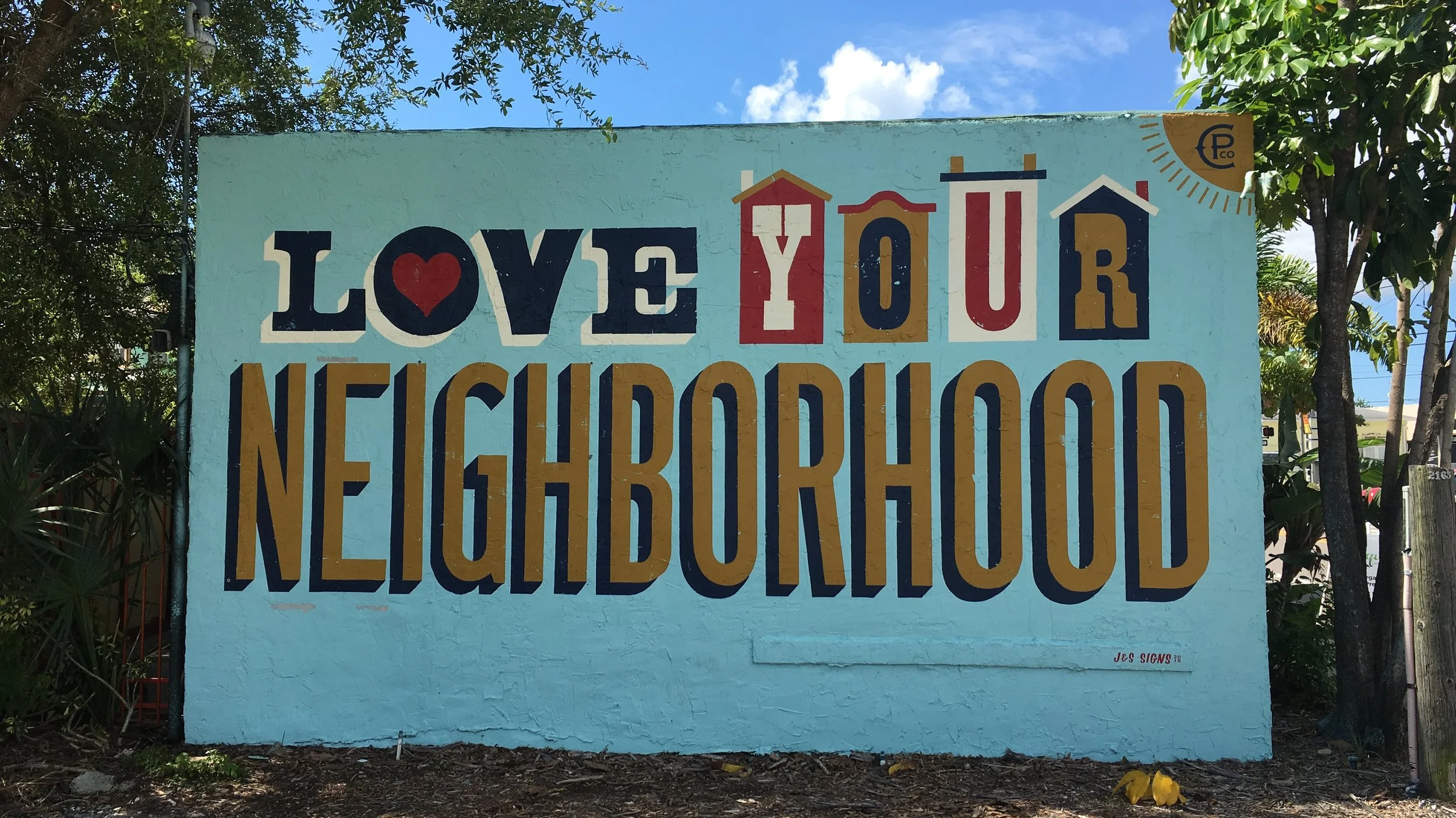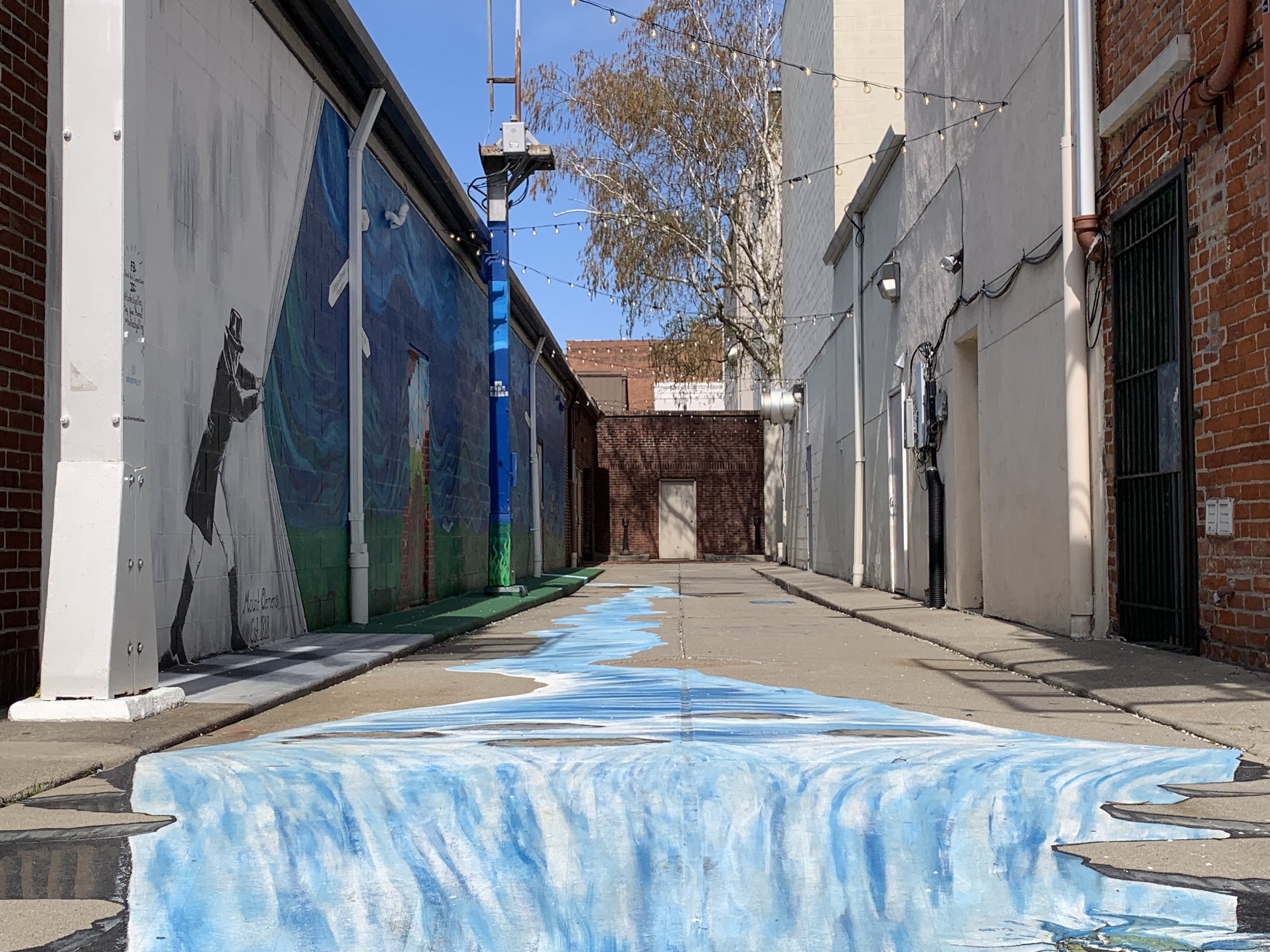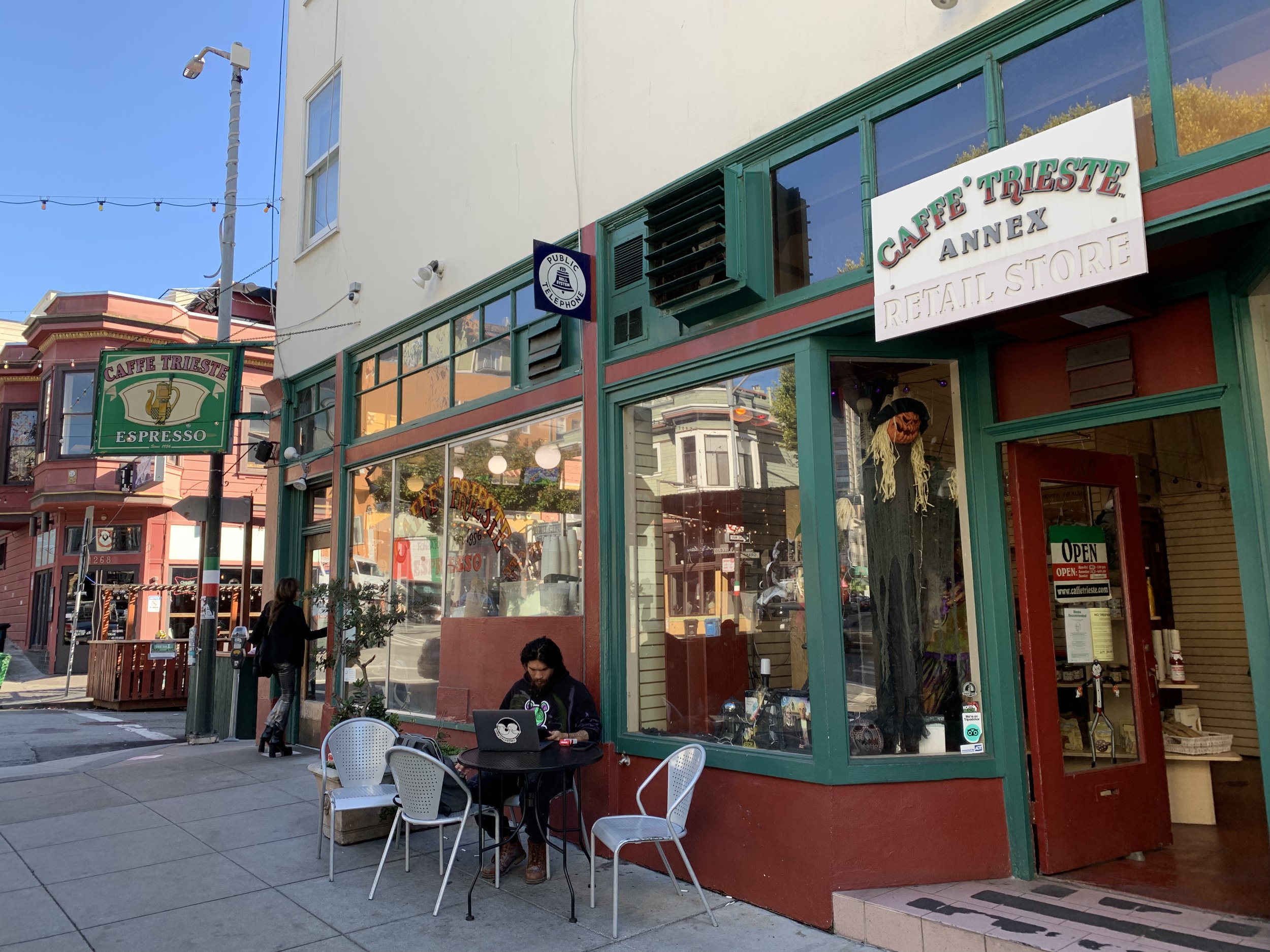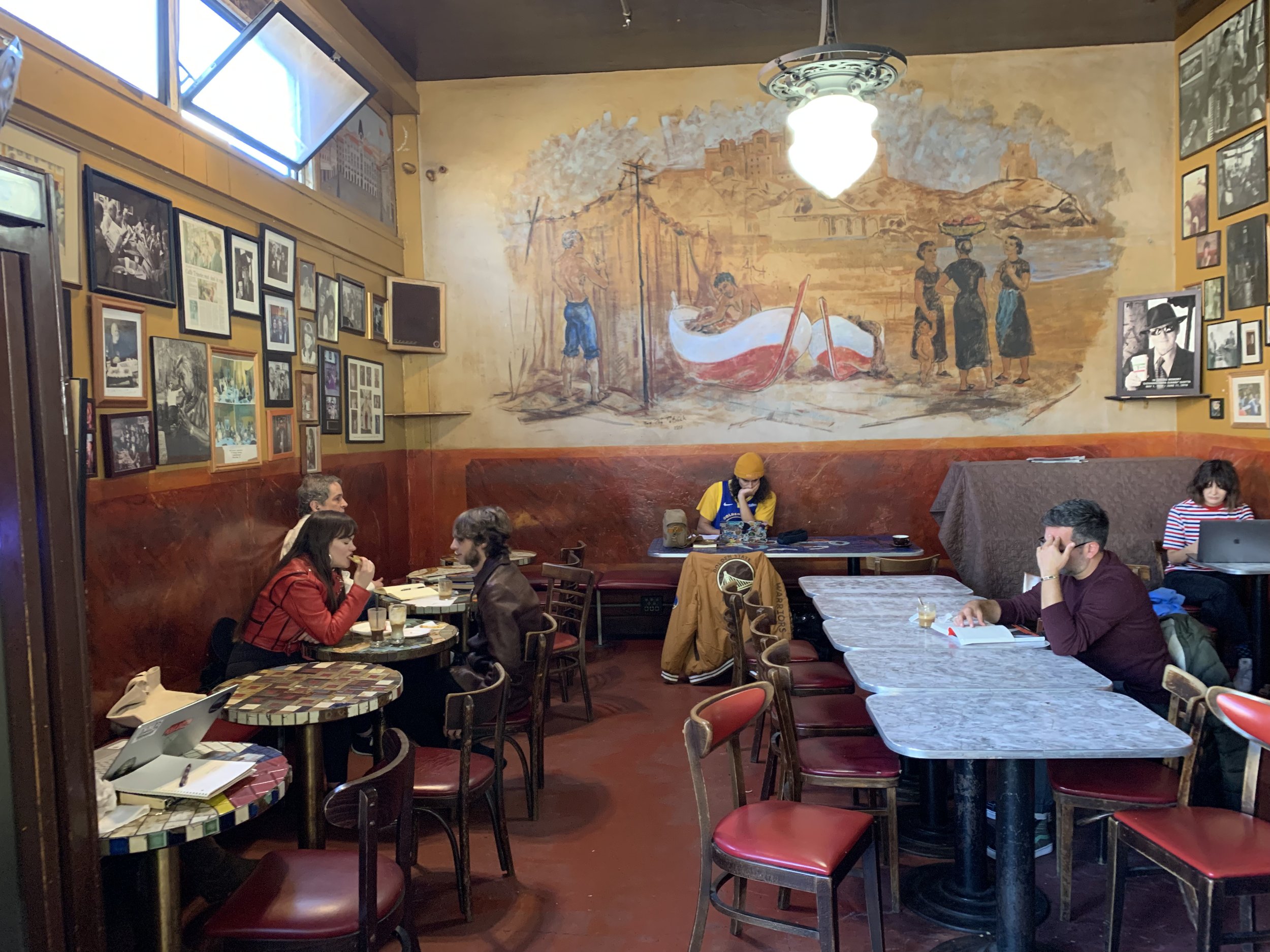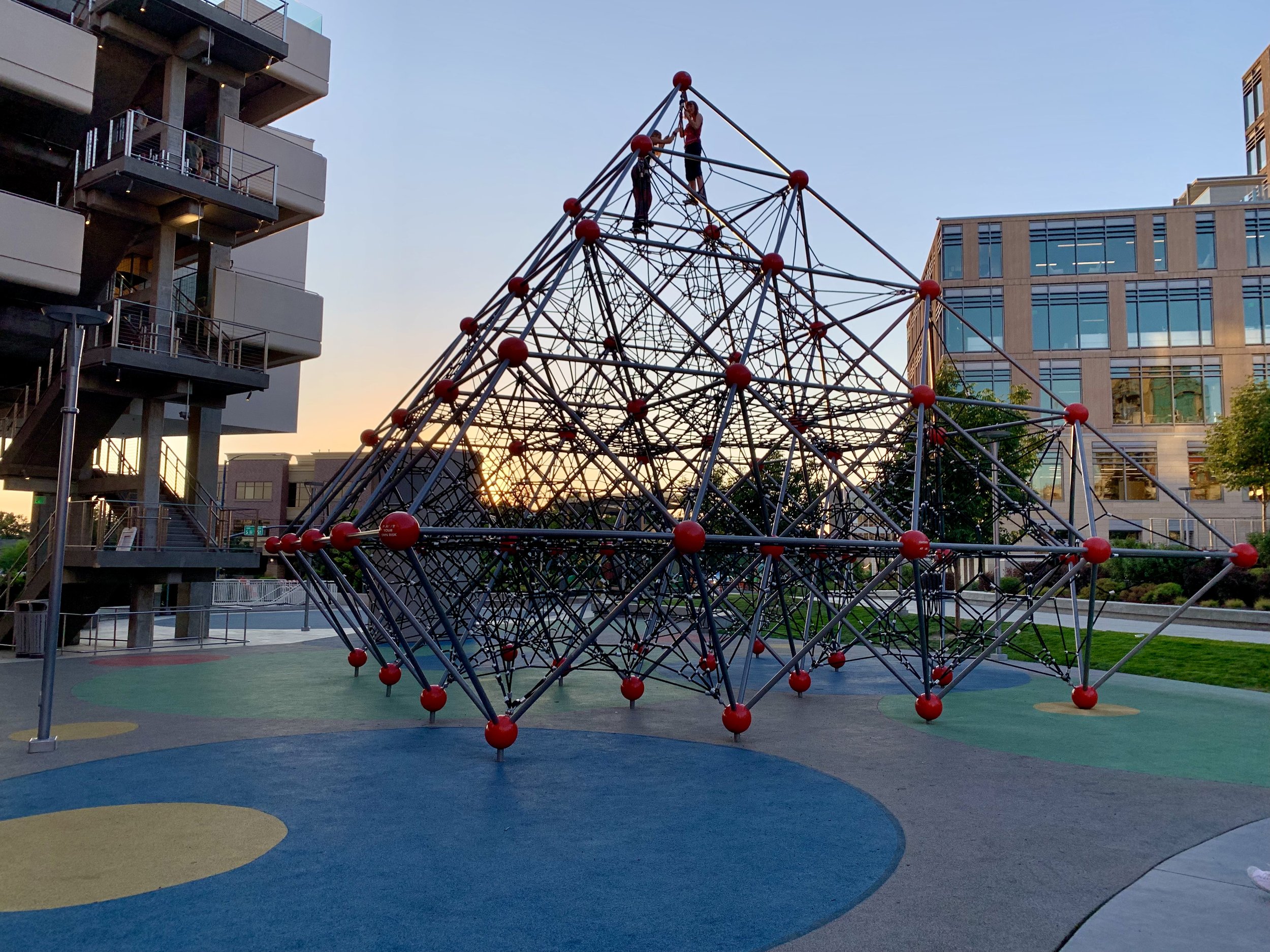With the reputation that Asheville, NC enjoys, it seemed completely in character to see this street busker in their downtown. I noted lots of dogs there as well!
Mural - Mount Clemens, Michigan
This clever mural actually leads you down the alley.
Classic Third Space - San Francisco, California
Caffe Trieste in the North Beach neighborhood of San Francisco has been a community gathering space since the Beat poets and writers of the 1950’s would gather there for espresso and conversation. Not at all fancy but absolutely a love note.
Tiny Love Note - Portland, Oregon
Mill Ends Park in Portland, Oregon is known as the world’s smallest official city park. For over 60 years, this tiny park has delighted visitors and locals alike.
Adult Sized Fun - Boise, Idaho
Adult sized jungle gym in downtown Boise.
Surprise and Delight in Sweden
As you may know, I am a big fan of the small things that surprise and delight us in cities. These little 'love notes' have an outsized impact on the experience of the place and ultimately how we feel about those places. Great example here from Sweden.
Mash Up for Halloween
I was speaking with a group from the Alliance for Innovation today on a webinar and was challenging them to think about ways of adding fun to the mix of our various projects. I mentioned the idea of a neighborhood clean up which is a good, solid community project but not necessarily thought of as ‘fun’ in the traditional sense. So based on the current season, I opined that maybe we could mash up a Trick or Treat event with a neighborhood clean up and make the later a more fun and engaging event. Seems like a natural fit. If any communities out there have done something like this, I’d love to hear about it!
Water Slide in Bristol, UK
A giant water slide in the heart of Bristol, England is the brain child of artist Luke Jerram, previously known for his street pianos project. Some may recall that Grand Rapids, Michigan did a similar project in 2010spearheaded by Rob Bliss, who went on to produce the famous Grand Rapids Lip Dub in 2011.
Bristol Story: http://www.citylab.com/design/2014/05/plan-turn-steep-street-giant-water-slide-was-huge-success/9039/
DIY Traffic Calming
Here’s an example of taking matters into your own hands. DIY city making continues to expand as people become emboldened to make necessary changes in their own communities. Hopefully the official city makers take note that change can and will happen even without their support and permission. Cheers to those that break/bend the rules in order to get our communities to the place we actually want to be.
Story here: http://www.citylab.com/commute/2014/03/heres-diy-approach-slowing-citys-cars/8661/
Grande Prairie, Alberta – $500 Project Launches
One of the $500 prize winners from my Grande Prairie, Alberta workshop made their project happen. Congratulations!
South Bend Declares Its Love
In June I wrote a piece called “The Surprising Life in America’s Dying Cities” for Infrastructurist.com. The piece highlighted the amazing things that were happening in the cities designated by Newsweek Magazine in January as the 10 most “dying” places. Needless to say, the cities on that list were not happy with the tag placed on them. Since I published that article, one more of those “dying” cities has stepped up to declare the rumors of their demise being greatly exaggerated.
South Bend, Indiana was number eight on the Newsweek list. And local radio personality Tori James did not like it. But not having budgets to counter the publicity, she decided that South Bend needed to remind itself of the good things it had in the community. She came up with the idea that the citizens should write “love notes” to the city. She took the idea to Downtown South Bend Inc. and they decided to run with it. Leveraging the radio station and the local paper they were able to get word of the project out to South Bend. They put actual mailboxes in several downtown shops and invited people to drop off their notes in person. Online submissions came from all over the country as hundreds of love notes came in.
Last week the city declared “I Love South Bend” day and the love notes were posted in the windows of shops throughout downtown. Local artists were brought in to paint the windows and seam together the notes into displays of the love and affection people have for their city.
While things like the Grand Rapids Lip Dub might get more external attention, one cannot underestimate the impact of these simple, heartfelt efforts such as South Bend has done. This project was BY them and FOR them. A declaration of love and connection that becomes part of a longer term effort to improve the relationship between city and citizen. Every community would do well to reflect on that relationship and hopefully do so without a scare or an outside threat.
Surprising Life in America’s “Dying” Cities
Here is the piece I wrote for Infrastructurist.com which challenges the way we think about statistics. In cities that Newsweek magazine declared to be “dying” we have seen amazing amounts of life and activity. Recall the recent post that showed New Orleans was the “coolest city for startups”; on Newsweek’s list, New Orleans was the #1 dying city.
Check out the piece which includes the amazing Grand Rapids Lip Dub – if you have not seen the video yet, you must check out the incredible response that Grand Rapids came up with to being declared a dying city.
Leadership as a Love Note
Here is a wonderful example of unconventional and exceptional leadership by Mayor Tom Brown of McPherson, Kansas. (I write about McPherson and Mayor Brown in the book.)
In January 2010, the city was gifted the local golf course. Many thought it a mixed blessing as the golf course had never been profitable. But it was an opportunity for the city and Mayor Brown challenged the staff by saying that if the golf course turned a profit, he would jump in the lake on the first hole. For the first time ever, the golf course turned a profit in 2010 and as you can see here, the Mayor is a man of his word!
This gesture not only created news all over the city and region, it was a simple little “love note” to the community. This small gesture has had an outsized impact on McPherson and is something that people will remember and smile about for a long time.
A Love Letter to Syracuse
In For the Love of Cities, I write about the Philadelphia Love Letter project by artist Steve Powers and the Philly Mural Arts program. With the success of that project, other cities have been asking Powers to work with them. Here is his latest work in Syracuse. Note in the video how he uses a community engagement process to really understand what people love about their city. And the result is wonderful!
Book Now Available!
I am very pleased to announce that For the Love of Cities is now available on Amazon.com!
The e-book version will be available in April.
Can Robocop Save Detroit? YES!
It started on Feburary 7th when a guy from Massachusetts tweeted to Detroit mayor Dave Bing that Robocop would make a great statue for the city, kind of like the Rocky statue in Philadelphia. Mayor Bing politely tweeted in response “There are not any plans to erect a statue of Robocop. Thank you for the suggestion.” Too late, a meme was born.
The idea spread like wildfire and soon a Facebook group was created by Detroiter John Leonard. The idea sparked Imagination Station founder Jerry Paffendorf to launch a KickStarter project to raise the money to actually build the state. They set the goal of $50,000 by March 26th to fund the project. A website was launched – detroitneedsrobocop.com and on February 16th the New York Times featured the story. As of today (February 19th), just 12 days since that fateful tweet, over $59,000 has been raised on Kickstarter by2187 people. Several sites for the statue have been offered and the project has galvanized supporters of Detroit from all over the world.
I wrote about Jerry Paffendorf in For the Love of Cities regarding his Loveland Project. Paffendorf had previously purchased 3000 square feet of land in the city and had begun to sell it off to people an inch at a time. The “inchvestors” were symbolically buying into the idea of Detroit and taking a piece (a very small piece) of ownership of the city. But his idea resonated with hundreds of inchvestors who bought their stake and “moved into” these virtual neighborhoods at the website. The funds raised by Loveland are being used to support other community projects, including the Imagination Station, a clean-up project that is turning two abandoned homes in the shadow of Detroit’s Central Station into public art space.
Some have suggested that this is a colossal waste of time and resources. One article called it “irony run amok” and some a concerned that a Robocop statue will dilute and devalue the public art that is already in the city. Paffendorf told the New York Times “Sometimes it takes a RoboCop to show a different way to do things. My hope is that it sets an example and puts this kind of funding on the map, so when people see big problems, they can think, ‘If crazy people raised $50,000 for a RoboCop statue, we can certainly raise more to take on something bigger.’ ”
Is one statue going to save the Motor City? No, of course not. But what this project represents – grassroots, Internet fueled efforts by people who love the city – THAT can save the city. Take this one small success, where they get people to invest a little bit of their money and time in the city. They network with each other and realize they are not alone. In fact there are many more of them out there than perhaps they ever thought (over 2100 supporters on Kickstarter and 7400 fans on Facebook). This success gives them confidence to try again and perhaps do something bigger (or more serious) next time. Repeat this ten times, a hundred times, a thousand times and that is real change. So to those that think this is a silly distraction from the city’s real problems, I say it is exactly the type of silly distraction Detroit and many other cities need.
Love Note: Pedestrian Friendly Times Square
Two of my favorite New York City love notes debuted in 2009: the newly pedestrian friendly Times Square and High Line Park in the Meatpacking District.
New York Mayor Michael Bloomberg and Transportation Commissioner Janette Sadik-Khan began pedestrian-friendly Times Square as an experiment in 2009. The response to their people space, created in the heart of the city, has been overwhelmingly positive. Complete with seating and free wifi, the area invites you to sit, people watch and amble in a way that the old Times Square did not. Sidewalks crowded with tourists and busy locals, surrounded by cars, did not make for a lovable place.
The experiment was made permanent in February 2010. Noted New York Magazine: “It took a bureaucrat’s intervention to make the place human again, to clear a little room for leisurely amazement in the lunatic center of this crazed metropolis.”
Street Films – In Appreciation of the NEW Times Square
This video features Danish architect Jan Gehl, Mayor Michael Bloomberg and Transportation Commissioner Janette Sadik-Khan.
Peter Kageyama from Pedestrian Friendly Times Square

